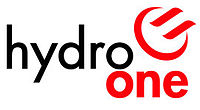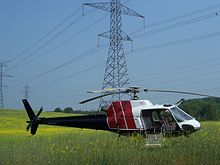- Hydro One
-
Hydro One Inc. 
Type Crown Corporation Industry Electricity delivery Predecessor Ontario Hydro Founded Toronto, Ontario (1999) Headquarters Toronto, Ontario, Canada Area served Ontario Key people - Laura Formusa
President & CEO - James Arnett
Chair of the Board
Products delivery of electricity Revenue  CA$ 4.7 Billion (2009)
CA$ 4.7 Billion (2009)Profit  CA$ 470 Million (2009)
CA$ 470 Million (2009)Total assets  CA$ 15.8 Billion (2009)
CA$ 15.8 Billion (2009)Total equity  CA$ 5.4 Billion (2009)
CA$ 5.4 Billion (2009)Owner(s) Government of Ontario Employees 5,427 regular employees
2,058 temporary, contract and part-time employees
7,070 pensionersParent Hydro One Inc. Subsidiaries Hydro One Networks Inc.
Hydro One Remote Communities Inc.
Hydro One Brampton Networks Inc.
Hydro One Telecom Inc.Website Hydro One Hydro One Incorporated delivers electricity across the Canadian province of Ontario. It is a Corporation established under the Business Corporations Act (Ontario) with a single shareholder, the Government of Ontario.[1]
Hydro One traces its history to the early 20th century to the establishment of the Hydro-Electric Power Commission of Ontario, renamed "Ontario Hydro" in 1974.
In October, 1998 the provincial government passed the "Energy Competition Act" which restructured Ontario Hydro with the aim of privatizing all electrical generating and transmission/delivery.
Contents
System Information
Hydro One's Transmission Line voltages are 500,000 volts, 230,000 volts and 115,000 volts. Hydro One has interconnections with Manitoba Hydro, Hydro-Québec, Minnesota Power, Detroit Edison/ITC, Niagara Mohawk Power and the New York Power Authority.
History
Hydro One was originally part of the Hydro-Electric Power Commission of Ontario, or Ontario Hydro, which was established in 1906 by the provincial Power Commission Act to build transmission lines to supply municipal utilities with electricity generated by private companies already operating at Niagara Falls. The first chairman was Adam Beck, minister without portfolio in the provincial government of Sir James P. Whitney. Beck had been a prominent advocate of a publicly owned electricity grid.
In the 1920s the commission began generating and distributing its own power when it was given the mandate to electrify rural areas. Besides building its own generating stations, it bought the transmission lines and generators of the largest private electricity company.
In 1974 the Power Corporation Act reorganized the system as a crown corporation called Ontario Hydro, the name it was most usually known by.
In 1998, the PC government of Mike Harris passed the Energy Competition Act which authorized the establishment of a market in electricity. In April 1999, Ontario Hydro was re-organized into five successor companies: Ontario Power Generation, the Ontario Hydro Services Company (later renamed Hydro One), the Independent Electricity Market Operator (later renamed the Independent Electricity System Operator), the Electrical Safety Authority, and Ontario Electricity Financial Corporation. The two commercial companies, Ontario Power Generation and Hydro One, were intended to eventually operate as private businesses rather than as crown corporations.
By 2001, Hydro One had acquired 88 municipal utilities. In December 2001 the provincial government announced the intention to sell Hydro One under an initial public offering, however by April 2002 various groups in opposition to the plan were able to successfully challenge the government in the Ontario Superior Court, forcing a halt to the IPO[1].
In 2002 an electricity market began operating. However, critics questioned, among other things, whether the market was truly competitive or could ever become competitive, given that an electricity grid is not a private good. Public dismay at an increase in prices led the government of Harris's successor, Ernie Eves, to freeze electricity prices for residential and small business consumers. This freeze was maintained after the Liberal party of Dalton McGuinty replaced the PC government in 2003. The freeze was removed and prices were raised in April, 2004, and have been increased again subsequently.
Restructuring
Ontario Hydro was restructured on April 1, 1999 into five separate entities: Ontario Power Generation, the Ontario Hydro Services Company, the Independent Electricity System Operator (originally named the Independent Electricity Market Operator), the Electrical Safety Authority, and Ontario Electricity Financial Corporation.
On May 1, 2000 the Ontario Hydro Services Company was renamed Hydro One Incorporated and reorganized as a holding company with four subsidiaries:
- Hydro One Networks Inc.
- Hydro One Remote Communities Inc.
- Hydro One Telecom Inc.
- Hydro One Brampton.
Between 1998 to 2000, Hydro One acquired 88 municipal electrical utilities. Numerous local/municipal distribution companies were also consolidated during this time.
In May 2002 the provincial government went ahead with the launch of an open electricity market, even though generating and distribution remained under control of the government.
Effective December 8 2006, President and CEO Tom Parkinson's resignation was accepted[2]. His resignation was prompted by a controversy surrounding use of company property and improper processing of personal expenses uncovered by the Ontario Auditor General.[3]
Hydro One also owns the distribution Utility for the city of Brampton Ontario. This is another Subsidiary known as Hydro One Brampton. This subsidiary operates separately from the main Hydro One corporation and operates only in the city of Brampton.
See also
References
External links
- Hydro One
- Historical timeline produced by Hydro One
- Hydro One annual reports available from 2000-2005
- Ontario Ministry of Energy
- Ontario Power Generation
- Ontario Electricity Financial Corporation
- Map of electric transmission facilities in OntarioPDF (3.2 MB)
Categories:- Ontario electricity policy
- Ontario Hydro
- Companies established in 1999
- Companies based in Toronto
- Power companies of Canada
- Laura Formusa
Wikimedia Foundation. 2010.


